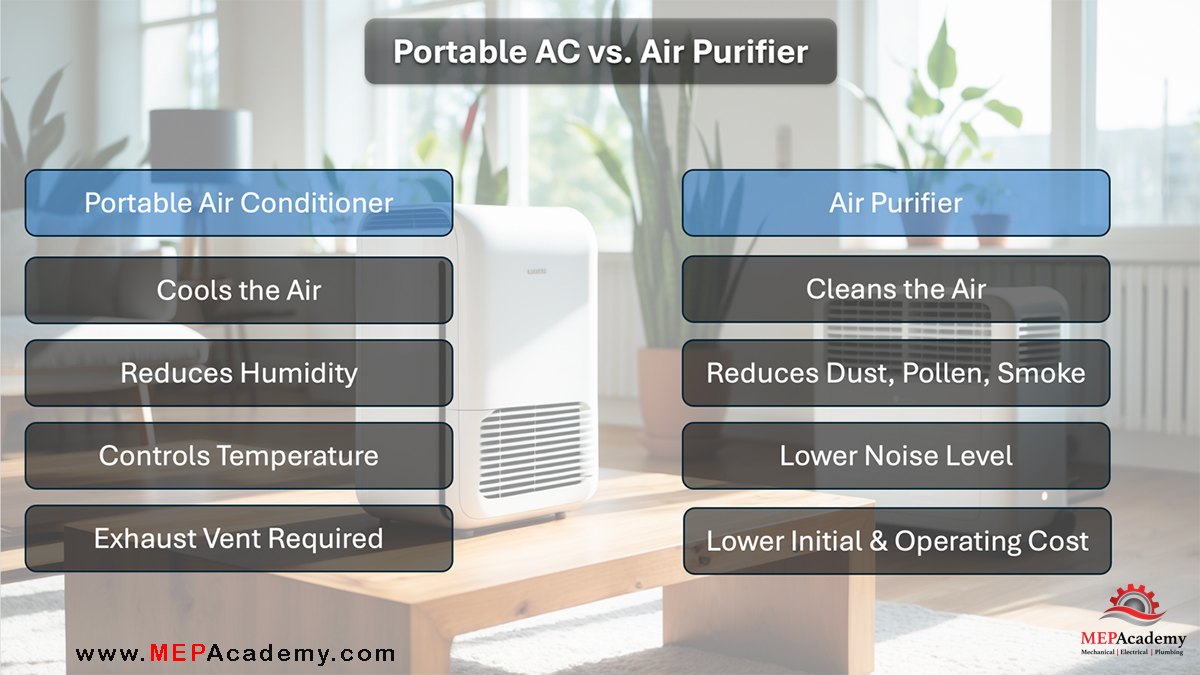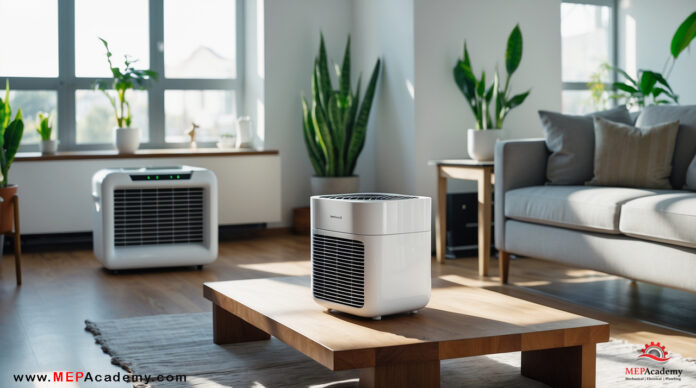When trying to improve indoor comfort and air quality, many people investigate portable air conditioners vs air purifiers. While they may seem similar at first glance—both being standalone appliances designed to enhance indoor environments—they serve entirely different functions. In this article, we’ll explore the key differences, provide an overview of each, and break down the advantages, disadvantages, and costs associated with them.
Key Differences
A portable air conditioner and an air purifier serve different purposes: a portable air conditioner is designed to cool the air and remove humidity, making the space more comfortable in hot or humid conditions, while an air purifier is meant to clean the air by removing dust, allergens, smoke, and other airborne pollutants.

Overview of Portable Air Conditioners
Portable air conditioners (PACs) are standalone cooling units designed to lower the air temperature in a specific area. They typically sit on the floor and are connected to a window via an exhaust hose to expel hot air.
How They Work
- Draw in warm room air.
- Cool it using a refrigeration cycle.
- Release the cooled air back into the room.
- Expel hot air outside through an exhaust hose.
Common Features
- Thermostat control.
- Fan speeds.
- Dehumidification function.
- Remote control or smart functionality.
Overview of Air Purifiers
Air purifiers are appliances that clean the air by removing contaminants such as dust, allergens, smoke, and pollutants. They do not control temperature or humidity but can significantly improve indoor air quality.
How They Work
- Draw in air through filters.
- Trap particles using HEPA, activated carbon, or ionization technology.
- Circulate cleaner air back into the room.
Common Features
- HEPA filters (capture 99.97% of particles ≥0.3 microns).
- Carbon filters for odors and VOCs.
- UV light or ionizers in some models.
- Smart sensors for real-time air quality monitoring.
Key Differences Portable Air Conditioner vs Air Purifier
| Feature | Portable Air Conditioner | Air Purifier |
| Primary Function | Cools the air | Cleans the air |
| Humidity Removal | Yes (dehumidifies as part of cooling process) | No (some may slightly alter humidity but not designed for it) |
| Air Cleanliness | Basic filtration (dust, large particles) | Advanced air purification (dust, pollen, smoke, VOCs, microbes) |
| Temperature Control | Yes | No |
| Initial Cost | $300–$700+ | $100–$500+ |
| Operating Cost | Higher (electricity for compressor and fan) | Lower (fan only, filters need replacing periodically) |
| Exhaust Vent Required | Yes (usually through a window) | No |
| Noise Level | Moderate to high | Low to moderate |
Humidity Removal
- Portable Air Conditioner: Acts as a dehumidifier, pulling moisture from the air as part of its cooling cycle. Ideal for humid climates.
- Air Purifier: Does not remove humidity. Some advanced models may have combined humidifying or dehumidifying functions, but standard purifiers do not alter humidity.
Air Cleanliness
- Portable AC: May include a basic air filter (e.g., dust screen), but not designed for deep air purification.
- Air Purifier: Equipped with HEPA and/or carbon filters, it is highly effective in removing airborne particles, allergens, smoke, and odors.
Initial and Operating Costs
Initial Cost:
- Portable AC: Generally, more expensive upfront due to cooling components. Units range from $300 to $700+ depending on size and features.
- Air Purifier: More affordable, typically ranging from $100 to $500, with premium models going higher.
Operating Cost:
- Portable AC: Consumes more electricity; expect to pay $20–$80/month, depending on usage and energy rates.
- Air Purifier: Lower energy consumption. However, filter replacements can cost $30–$100 every 3–12 months, depending on the model and air quality.
Advantages and Disadvantages Portable Air Conditioner vs Air Purifier
Portable Air Conditioner
Advantages:
- Provides cooling and dehumidification.
- Portable and easy to install in temporary spaces.
- Flexibility to move between rooms.
- No permanent installation required.
- Quick setup and targeted cooling.
- Some models offer multi-functionality (cooling, fan, and dehumidifier modes).
Disadvantages:
- Noisy compared to other cooling methods.
- Requires venting through a window or opening.
- Limited purification capabilities.
- Limited cooling capacity for larger spaces.
- Requires regular maintenance (e.g., emptying water tanks in dehumidification mode)
Air Purifier
Advantages:
- Improves air quality, reducing allergens, odors, and airborne pathogens.
- Quiet operation in most models.
- No venting required.
- Lower energy usage.
- Improves sleep quality by minimizing irritants.
- Creates a fresher smelling environment.
Disadvantages:
- Does not control temperature or humidity.
- Limited effectiveness on particles settled on surfaces.
- Filter maintenance can be ongoing and costly over time.
Which One Do You Need?
It depends on your specific indoor needs:
Choose a Portable Air Conditioner if:
- You need to cool a room.
- You live in a hot or humid climate.
- Air purification is a secondary concern.
Choose an Air Purifier if:
- You want to improve indoor air quality.
- You or someone in your home has allergies, asthma, or respiratory sensitivities.
- Temperature and humidity are not major issues.
In some cases, using both together can provide the best of both worlds: cool, clean, and comfortable air.
Conclusion
Portable air conditioners vs air purifiers each serve important yet distinct roles in maintaining a comfortable and healthy indoor environment. Understanding their differences helps you choose the right appliance—or combination—for your home. Whether you’re battling summer heat or airborne allergens, making an informed decision will lead to better air and better living.
Frequently Asked Questions (FAQ)
1. What is the main difference between a portable air conditioner and an air purifier?
A portable air conditioner cools the room and removes humidity, while an air purifier cleans the air by removing allergens, dust, and pollutants. They serve completely different purposes.
2. Can an air purifier cool a room?
No, air purifiers do not cool the air or control temperature. They only filter out airborne contaminants to improve air quality.
3. Do portable air conditioners clean the air?
Portable AC units have basic filters that catch large dust particles, but they are not designed to purify air like HEPA-based air purifiers.
4. Can I use a portable air conditioner and an air purifier together?
Yes! Using both together can enhance comfort by cooling the air and improving indoor air quality at the same time.
5. Which is better for allergies: air purifier or portable AC?
An air purifier is better for allergies because it captures allergens like pollen, pet dander, and dust mites. Portable ACs don’t offer the same level of filtration.
6. Does a portable air conditioner reduce humidity?
Yes, portable air conditioners act as dehumidifiers while cooling the air, which can help make indoor spaces more comfortable.
7. Are air purifiers energy efficient?
Yes, most air purifiers use very little electricity. However, they may require regular filter replacements, which adds to the long-term cost.
8. Do portable AC units need to be vented?
Yes, portable ACs must be vented to expel hot air outside, typically through a window using an exhaust hose.
9. Which is more expensive to operate: a portable AC or an air purifier?
Portable ACs generally cost more to operate due to higher electricity usage. Air purifiers have lower power consumption but may need frequent filter replacements.
10. What size portable air conditioner or air purifier do I need?
It depends on the room size. For portable ACs, look at BTU ratings. For air purifiers, check the Clean Air Delivery Rate (CADR) and square footage recommendations.







